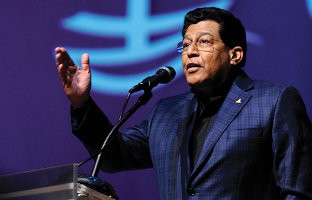
The new Calvary Convention Center in Kuala Lumpur, Malaysia, was filled nearly to capacity as 3,710 Pentecostals gathered from 73 countries around the world. They came to this mostly Muslim country for the 23rd Pentecostal World Conference, a global gathering which takes place every three years. The host was Calvary Church, a Pentecostal megachurch in Kuala Lumpur whose lead pastor, Prince Guneratnam, is currently chair of the Pentecostal World Fellowship.
Many participants at the August meeting were young and reflected the enthusiasm of the fastest-growing segment of the Christian world. In 1970 Pentecostals accounted for only 5 percent of all Christians, but today Pentecostals and charismatics—including those in other denominations who exercise Pentecostal or charismatic gifts—constitute 25 percent of all the world’s Christians. In Asia, 80 percent of all Christian conversions are to Pentecostal forms of Christianity. Or think of it this way: one out of 12 people alive today is Pentecostal.
I attended the Kuala Lumpur meeting as part of a delegation from the Global Christian Forum, an ecumenical initiative drawing together all the major families of world Christianity and supported by the World Council of Churches, the World Evangelical Alliance, the Vatican’s Pontifical Council for Promoting Christian Unity and the Pentecostal World Fellowship, among others. Before leaving for Malaysia, I spoke with an outstanding journalist who covers religion for a leading U.S. newspaper. She had not heard anything about the Pentecostal World Conference.





